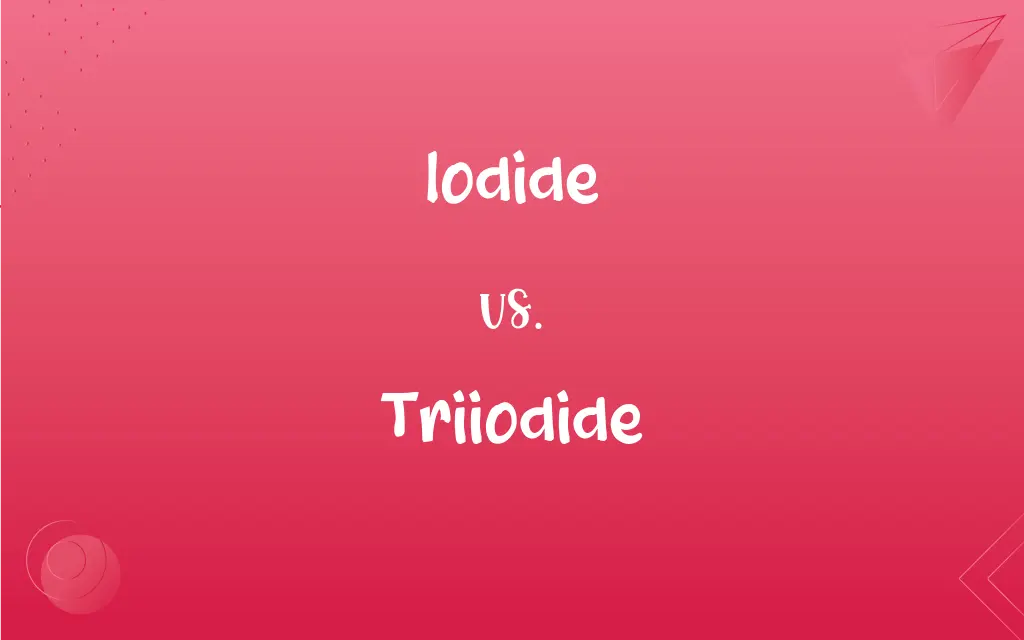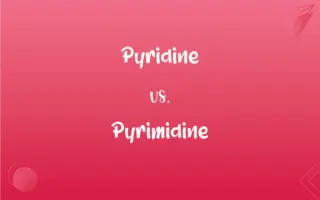Iodide vs. Triiodide: What's the Difference?
Edited by Aimie Carlson || By Harlon Moss || Published on January 4, 2024
Iodide is a monoatomic anion of iodine (I⁻), often in salt form, while triiodide is a polyatomic ion consisting of three iodine atoms (I₃⁻).

Key Differences
Iodide, represented chemically as I⁻, is a simple anion formed when iodine gains an electron, commonly found in table salt. In contrast, triiodide, denoted as I₃⁻, is a complex ion formed by an iodide ion and a diatomic iodine molecule.
Iodide is often used in nutritional supplements for thyroid health, being a simpler form of iodine. Triiodide, however, is more complex and plays a role in analytical chemistry, particularly in starch testing.
In terms of stability, iodide is relatively stable and can be found naturally in the environment. Triiodide, on the other hand, is less stable and is usually created in laboratory conditions.
Iodide is vital for human health, being a key component of thyroid hormones. Triiodide does not have such biological roles and is primarily of interest in chemical research.
The physical properties of iodide salts, such as solubility, are well-characterized. Triiodide's properties are more complex due to its larger molecular structure.
ADVERTISEMENT
Comparison Chart
Composition
Single iodine atom
Three iodine atoms
Stability
Relatively stable
Less stable
Role in Health
Essential for thyroid health
No known biological role
Chemical Complexity
Simple anion
Complex ion
Usage
Nutritional supplements, salts
Analytical chemistry, starch tests
ADVERTISEMENT
Iodide and Triiodide Definitions
Iodide
Iodide is an anion of iodine with a -1 charge.
Potassium iodide is a common source of iodide in dietary supplements.
Triiodide
Triiodide is a polyatomic ion composed of three iodine atoms.
Triiodide ions form when iodine crystals dissolve in a solution containing iodide.
Iodide
Iodide can act as a reducing agent in chemical reactions.
In the laboratory, iodide is often used to reduce other substances.
Triiodide
Triiodide is used in analytical chemistry for starch detection.
The triiodide-starch complex turns blue, indicating the presence of starch.
Iodide
Iodide is a component in iodized salt to prevent iodine deficiency.
Iodized table salt contains a small amount of sodium iodide.
Triiodide
Triiodide is less stable than simple iodide ions.
Triiodide can decompose into diatomic iodine and iodide under certain conditions.
Iodide
Iodide is used in radiology for contrast media.
Sodium iodide is injected as a contrast agent in medical imaging.
Triiodide
Triiodide has distinctive optical properties.
The deep coloration of triiodide solutions is used in various chemical tests.
Iodide
Iodide is found naturally in seawater and certain foods.
Seaweeds are a rich source of natural iodide.
Triiodide
Triiodide is formed in iodine clock reactions in chemistry.
The sudden appearance of blue color in an iodine clock reaction is due to triiodide formation.
Iodide
Univalent anionic iodine, or a compound of iodine, especially a binary compound of iodine with a more electropositive element.
Triiodide
(chemistry) Any compound containing a I3- moiety consisting of three iodine atoms in a more or less linear configuration.
Iodide
(inorganic chemistry) A binary compound of iodine and another element or radical.
Triiodide
(chemistry) Any iodide of a trivalent element that contains three I- ions.
Iodide
A binary compound of iodine, or one which may be regarded as binary, in which iodine has a valence of -1; as, potassium iodide.
Iodide
A salt or ester of hydriodic acid
FAQs
Are iodide and triiodide the same?
No, they differ in composition and properties.
Where is iodide found?
Iodide is found in iodized salt, seawater, and certain foods.
What is the use of triiodide in chemistry?
Triiodide is used in starch tests and as an indicator in iodine clock reactions.
Is triiodide stable?
Triiodide is less stable than iodide.
What is iodide?
Iodide is a negatively charged ion of iodine, commonly found in salts.
What is triiodide?
Triiodide is a polyatomic ion consisting of three iodine atoms.
Is iodide essential for health?
Yes, it is crucial for thyroid function.
How is triiodide formed?
Triiodide forms when iodine reacts with iodide ions.
Can iodide be used in radiology?
Yes, as a contrast agent in imaging.
Is triiodide naturally occurring?
It is rarely found in nature and is usually created in labs.
What is the charge on an iodide ion?
The charge is -1.
Can iodide be toxic?
In large amounts, it can be harmful.
How does iodide support thyroid health?
It's used to make thyroid hormones.
Are there any risks in handling triiodide?
It should be handled carefully due to its reactivity.
Can iodide deficiency affect health?
Yes, it can lead to thyroid disorders.
What is the difference in solubility between iodide and triiodide?
Iodide salts are generally more soluble.
What foods contain iodide?
Seafood, dairy products, and iodized salt.
What is the role of triiodide in the iodine clock reaction?
It's responsible for the sudden color change.
Are there any environmental concerns with iodide or triiodide?
Excess iodide can affect water ecosystems, but triiodide is not a common environmental concern.
What is the charge on a triiodide ion?
Also -1, but with a more complex structure.
About Author
Written by
Harlon MossHarlon is a seasoned quality moderator and accomplished content writer for Difference Wiki. An alumnus of the prestigious University of California, he earned his degree in Computer Science. Leveraging his academic background, Harlon brings a meticulous and informed perspective to his work, ensuring content accuracy and excellence.
Edited by
Aimie CarlsonAimie Carlson, holding a master's degree in English literature, is a fervent English language enthusiast. She lends her writing talents to Difference Wiki, a prominent website that specializes in comparisons, offering readers insightful analyses that both captivate and inform.































































